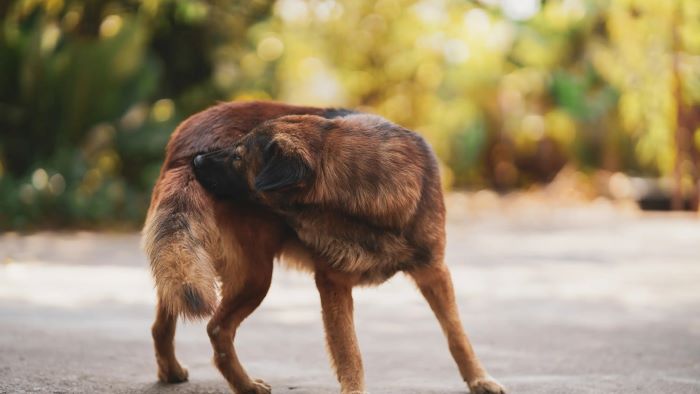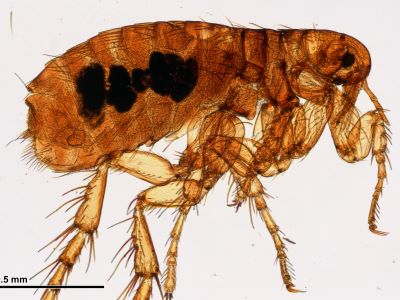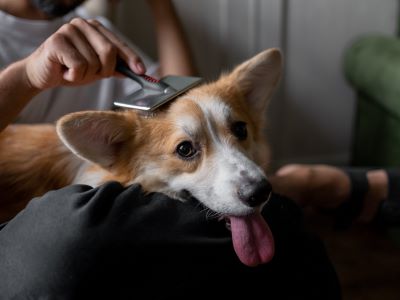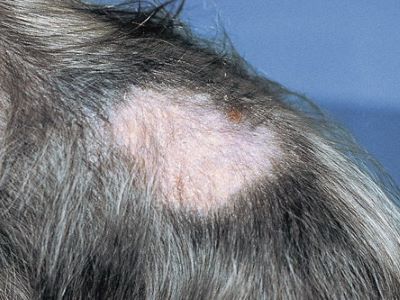Dogs, your best friends, they have fun outdoors. They roll around in the dirt, they jump into unknown water sources and who can forget bushes! They’re the best to jump into. Overall dogs like fun and being dirty.

And when they come indoors after a long day, you realize they’re itchy and scratching all over. This is because they have brought with them, FLEAS! Those tiny insects that look like dirt, are most harmful to your pet’s health. But, what exactly are they?
Key Takeaways
- Fleas are 3mm long parasites that survive by sucking the blood of animals and humans.
- To humans, fleas can look like dust particles as they are reddish brown in color.
- Fleas live on the thickest area of the dog, which means the base of the tail, groin area and back of the legs.
- Use a Flea Comb to check for fleas. If you find them, take immediate action and begin treatment with tick and flea shampoo and powder.
- Humans can get bitten by Fleas but they won’t survive on humans due to lack of fur.
- To prevent fleas use a dog collar and flea shampoo all year long.
What are Fleas?
Fleas[1] are tiny wingless parasites that survive by sucking the blood of animals and humans. They usually have four to six legs, they use their back legs to jump. They can jump up to 8 inches at a time, which is remarkable considering they are only 1.5 to 3.3 mm long.
Fleas use their mouth to pierce the skin. Their saliva contains anticoagulants which promotes blood flow. Female Fleas also plant eggs after feeding. They can cause itching, rashes, and hair loss.
“Fleas are the most prevalent parasite found on fur-bearing animals, such as dogs and cats. There are an estimated 2,000 species of fleas worldwide, and more than 300 types are found in the United States.” – An expert from pestworld.org
What Do Fleas Look Like?
To the naked eye, fleas look like dirt speckles. They are reddish brown and black in color. However, if looked under a microscope, you’d be able to see a head, an oval abdomen, and six legs. In a dog with dark fur, it is much more difficult to see.

Fleas are not always visible, they are very quick to hide in thick fur. They are parasites after all and jump from one fur spot to another, sucking blood and laying eggs. To check for fleas, brush your hand from tail to head in an upward motion.
How To Inspect Dogs For Fleas?
The thickest area, with the most fur, is typically home to fleas. Be sure to check at the base of the tail, near the groin area, and behind the legs. Brush upwards from the base of the tail to check for fleas. What you’ll spot will usually be flea filth rather than real fleas.
You can use a Flea Comb, with fine bristles to comb through the fur and remove fleas. It can also help remove the eggs and dirt. It is a cheap and effective way of treating fleas.

Tip: Apply some Petroleum Jelly on the bristles for a productive combing session. After the fleas are caught, shake them off into Isopropyl alcohol or just soapy water and flush it down the toilet.
How To Treat Flea Invasion?
It is important to treat them in the early stages. Fleas can lead to serious illnesses like Anemia, due to flees sucking pup’s blood and Lyme Disease. Additionally, dogs are allergic to fleas’ saliva.
Here are some signs to look for before it reaches that stage.
- Biting and scratching their skin
- Hair loss

- Red pimples in areas of belly, groin area, and base of the tail
On finding fleas, contact your veterinarian. They will suggest a treatment plan involving shampoos and powders. Flea and tick shampoo covers the entire fur and cleanses your pet of parasites and their eggs.
How To Prevent Fleas?
After a flea invasion[2], make sure to clean dog beds, carpets and, sofas. This will stop fleas from returning to your dog. You can also dust some flea-repellant powder on their beds.

Technology has come a long way with dog collars. Flea collars are innovative solutions. They release ingredients on dog’s body, it provides all-round protection to your pet, keeping the fleas at bay. Some collars are also odorless so that they don’t irritate your dog’s sensitive nose.
It is best to consult your vet before purchasing collars. The simplest approach to prevent fleas is to use prescribed shampoos and products all year round. This paired with regular inspection for fleas will keep your dog in health.
FAQs
Can dog fleas harm humans?
Fleas can jump on oblivious humans and bite them. However, humans lack fur and thus are not suitable hosts for fleas. Their bites can cause an allergic reaction.
What kills fleas immediately?
A hot soapy bath can help kill adult fleas. Flea medication like Nitenpyram, an oral pill can kill fleas within 30 minutes.
What happens if you don’t remove fleas from a dog?
When fleas bite, they release their saliva which can cause allergic reaction in dogs. Dogs can also develop anemia due to parasites sucking blood.
How long will fleas stay on a dog?
Once fleas have found the perfect host, a dog with thick fur, they will stay there until they are removed. They will also multiply by mating and laying eggs.
Why does my dog keep getting fleas?
After a flea invasion, it’s critical to clean dog beds, carpets, and couches because your dog may carry the parasites into these areas.
Conclusion
It’s important to keep your dog clean and to brush their fur on a regular basis. This aids in flea detection and shedding. You can contribute to the dog’s health by using preventive measures like maintaining a bath routine, and using flea-repellant powder and a collar.
A flea-free dog is a healthy dog. They are nice to pet and even nicer to cuddle. It will also save a ton of money you’ll have to pay if your dog gets infested. Remember, Prevention is better than Cure.
References:
- Fleas | University of Missouri (2014, August 1).
- Flea and tick prevention. (2023, March 28). Cornell University College.



